Spur HRX-3 and DF Prescysol EF (April 30, 2009)
Black & white emulsions offer an amazing spectrum of characteristics that can be controlled by different types of developers. The basic triangle of speed, grain and sharpness can only be altered within physical limits. But there is much latitude here. Tonal differentiation is another topic of much interest.
Choice of film
There is much discussion and a large amount of literature and test results with respect to the superiority and usefulness of the two main ISO100 contenders: T-Max100 and Delta100. The general opinion is that the grain of Tmax is just finer and that definition is just better with Delta100. It is a matter of taste. The other alternative is the classical FP4 emulsion, which shows more grain, but as an outstandingly good tonal differentiation. For my tests I use the Tmax 100 film, simply because this is a film I have been using since its introduction and I am familiar with it.
Scanning problems
The quality of the film and developer combinations is such that the process of scanning and digitizing for web presentation inevitably implies a loss of information and thus comparison issues. An important aspect is the definition of the film.The resolution limit of the film is much higher than can be captured with the scanning process. As an example: the detail of the testchart seen here is a very small part of the total negative: the vertical pattern designated 1.0 is just 20 pixels wide on a total negative width of 5688 pixels! These 20 pixels cover a line bar pattern of 10 lines (five black and five white) and every line then spans two pixels, close to the minimum required for good digital reproduction. On the negative the 1.6 pattern is clearly visible and the 2.0 pattern is barely visible. I used the Nikon Coolscan 5000ED with Silverfast software. A high end scanner might be able to get better results, but for most persons, such a scanner is beyond scope.
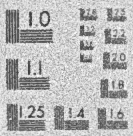
The digital files are 40 million pixels in size (16 bit scanning in grey mode). The reproduction of the full negative is at best 800 pixels wide with 72 pixels. That is a enormous reduction in image information.
The Spur HRX-3
This developer is a general purpose fine grain developer designed to get finest possible grain and a very fine tonal gradation with good definition and only a minimal loss of speed. Since a long time film manufacturers use the Exposure Index as an alternative to the official ISO values, which are not often suitable for pictorial work. For the Tmax 100 and HRX-3 I used an EI of 80, which is quite good. See below the graph.
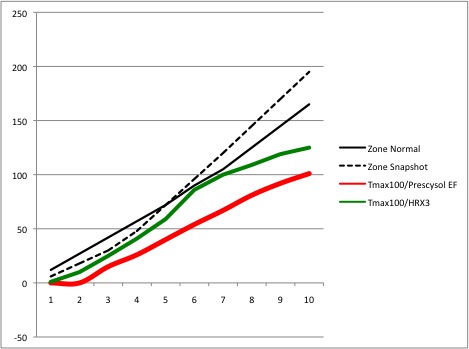
Grain is minimal and sharpness very good. The resolution is excellent with a value of 80 and tonal gradation is outstandingly good. See the example below.
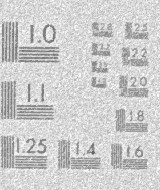
The characteristic curve is quite straight with a very good shadow detail capture. The density values are below the values that the strict zone system dictates. But the ZS values are not always necessary for superb monochrome work. If you really need tonal differentiation in the Zones 1 and 2, a speed reduction of a full stop is required, bringing the Tmax to an EI of 50. In many circumstances such deep shadows are not existent in many scenes so it is a bit a waste of speed to ask for such overexposure. And you will lose definition when over exposing. The HRX-3 then is a worthy contender for the CG512 developer. The HRX is easier to handle and has a longer keeping period. Basically there is not much difference between the two developers, slightly better edge sharpness for the CG512 and better tonal scale for the HRX. If you are exposing many film rolls, you can allow the luxury of a range of developers in the darkroom, dedicated for the requirements of the print and the scene. In all other cases you need to choose. The Spur HRX-3 is a very tempting general purpose developer.
Prescysol EF
This is a tanning developer. Tanning developers are known since 1896 and their principal action is to harden the gelatin and to remove the unexposed gelatin, leaving a layer of gelatin which varies in thickness in proportion to the intensity of the light exposure. The developing agent responsible for this action is pyrogallol and the tanning process is also known as pyro negatives. The PMK formula is a general prescription for creating a tanning developer.
The Photographers’ Formulary company produces the Prescysol EF as their tanning developer. The Pyro aficionados claim all kinds of characteristics for the negatives developed in pyro chemicals. Sharpness and definition are indeed outstandingly good. The resolution I could measure is above 90 lp/mm and 100 lp/mm can be reached. This is an excellent value for a normal emulsion with moderate speed.
Below left: Prescysol, below right: HRX-3
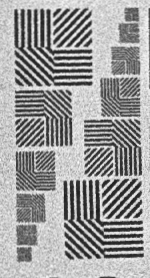
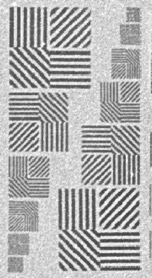
Grain is fine, but the silver seems to be blackened and the sharp edges produce good acutance but also a slightly rough grain impression. This is not unpleasant and only visible at large magnifications. The characteristic curve shows two remarkable properties: the lack of shadow detail and a very good reproduction of the specular highlights. I used an EI of 100 (as recommended by the manufacturer of the developer). When really deep shadows must be recorded I would recommend the EI of 50 - 64. The most important aspect of the use of Pyro is the so called three dimensional effect caused by the edge effects and the negative clarity. The reproduced section of the locomotive scene does indeed show this effect.
Tanning developers do not work well with all films and there is much difference in use and properties. I have to say that the Prescysol version is easy to use, has no bad side effects (staining is subtle and evenly distributed).
Conclusion
Leica photographers who are looking for a film/developer combo that enhances the special characteristics of Leica lenses would be well advised to start experimenting with Pyro developers, of which the Prescysol EF is a very good example. I will start testing several other tanning developers.
This type of developers delivers excellent imagery of a special quality that is well suited to Leica lenses.
In a more general approach we have now three clearly different types of developer for one film: the general purpose developers like HRX-3 or the GC512 for general use, the microfilms for high definition photography and the pyro/tanning developers for prints that are reminiscent to large format fine prints. The Weston look so to speak.
What more do we want: one camera body, one lens, two films and three developers to cover an extremely large range of print qualities.
It is really sad that we now have outstandingly good film emulsions and developers for a wide variety of image quality, simple and easy processing and century long keeping properties at the same moment when the classical camera manufacturer par excellence is looking away from these processes, obsessed as they seem to be by digital capture.






